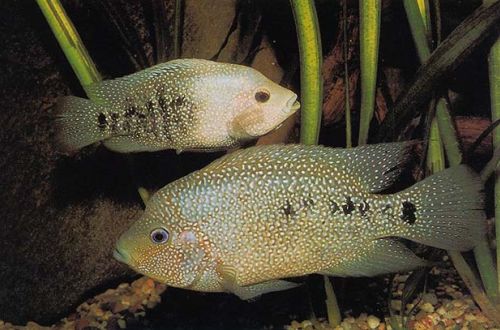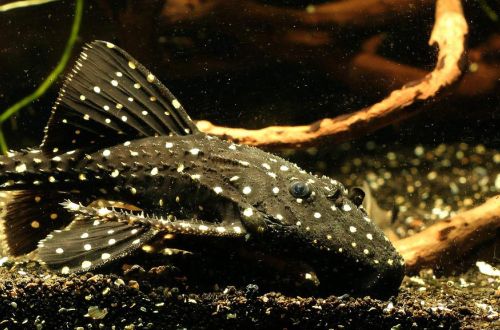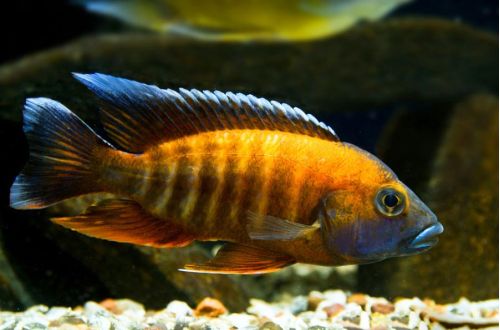
Pleco Green Phantom
Pleco’s green phantom (Plecostomus), scientific name Baryancistrus demantoides, belongs to the Loricariidae (Mail catfish) family. Beautiful temperamental catfish. In small aquariums, they are usually kept alone due to complex intraspecific relationships. Due to some features (behavior, nutrition) it is not recommended for beginner aquarists.

Contents
Habitat
It originates from South America from the region limited by the confluence of the Orinoco and Ventuari rivers (Yapacan National Park) in the Amazonas state of Venezuela. A typical biotope is a section of a river with a slow steady flow, rocky substrates and muddy dark water, colored brown due to the abundance of dissolved tannins formed as a result of the decomposition of plant organic matter. Sexual dimorphism is weakly expressed, there are no visible differences between male and female.
Brief information:
- The volume of the aquarium – from 200 liters.
- Temperature – 26-30°C
- Value pH — 5.5–7.5
- Water hardness – 1–10 dGH
- Substrate type – sand, gravel
- Lighting – any
- Brackish water – no
- Water movement – light or moderate
- The size of the fish is about 15 cm.
- Nutrition – vegetable feed
- Temperament – inhospitable
- Keeping alone or in a group in a large aquarium
Description
Adult individuals reach a length of up to 15 cm. The catfish has a somewhat flattened body, covered with rough plates with numerous spines or spikes. The abdominal cavity is partially covered with bony scutes. The muzzle is rounded, the mouth is large with long premaxillary openings. Gill openings are small. The greenish coloration contains light spots.
Food
In nature, it feeds on algae growing on stones and snags, and small invertebrates inhabiting them. In a home aquarium, the daily diet should be appropriate. You can use dry food based on plant ingredients, as well as place pieces of green vegetables and fruits on the bottom. Additionally, fresh or frozen brine shrimp, daphnia, bloodworms, etc. are served.
Maintenance and care, arrangement of the aquarium
The optimal size of the aquarium for one fish starts from 200 liters. In the design, it is desirable to recreate conditions that mimic the river bottom with a substrate of stones, sand, fine gravel and several large snags, plants with hard leaves. Bright lighting will stimulate the natural growth of algae, another source of food.
Like many other fish species that naturally live in flowing waters, the Pleco Green Phantom is intolerant of the accumulation of organic waste and requires high water quality within an acceptable temperature and hydrochemical range. For successful maintenance, it is necessary to ensure effective filtration and aeration of water, as well as to carry out mandatory maintenance procedures for the aquarium. At a minimum, it will be necessary to replace part of the water (40-70% of the volume) with fresh water weekly and regularly remove organic waste.
Behavior and Compatibility
Young catfish are peaceful and are often found in a group. Behavior changes with age, especially in males. Plecostomuses occupy a site at the bottom of the aquarium and become intolerant of potential rivals – relatives and other fish. In small volumes, there should be only one catfish, where they can be compatible with species that live in the water column or near the surface.
Breeding / breeding
Breeding in a home aquarium is possible, but only in spacious aquariums. Sometimes you will need a tank of at least 1000 liters, since it is difficult to determine the sex, you have to purchase several catfish at once in order to guarantee the presence of at least one male / female pair. At the same time, there should be enough space for everyone so that everyone can form their own territory. Spawning occurs in shelters formed from intertwined snags. Ordinary decorative items made in the form of grottoes, caves, etc. are also suitable. At the end of spawning, the female swims away, and the male remains to guard the masonry and future offspring.
Fish diseases
The cause of most diseases is unsuitable conditions of detention. A stable habitat will be the key to successful keeping. In the event of symptoms of the disease, first of all, the quality of the water should be checked and, if deviations are found, measures should be taken to correct the situation. If symptoms persist or even worsen, medical treatment will be required. Read more about symptoms and treatments in the Aquarium Fish Diseases section.





